- Home
- Technical Cooperation Projects
- Index of Countries
- Africa
- Mozambique
- Project on Strengthening Resilience in Cyclone IDAI-Affected Areas
- Project News
- The 1st training in Japan - Story in the Tohoku Region 1: Japan's reconstruction policy, city reconstruction planning and community vitalization (Feb. 20 to 22, 2020) -
Project News
2020-04-30
The 1st training in Japan - Story in the Tohoku Region 1: Japan's reconstruction policy, city reconstruction planning and community vitalization (Feb. 20 to 22, 2020) -
The participants visited three areas in Miyagi Prefecture from February 20 to 24, 2020, including Sendai City, Ishinomaki City, Natori City, and Minami-Sanriku Town in order to understand the reconstruction planning after the earthquake as well as the town development and livelihood recovery in the Tohoku Region. As Mozambique is in summer during February, the participants felt freezing in the winter season of Tohoku. But they actively asked questions in the Q&A session after each lecture, even when walking outside. This article covers the training from February 20 to 22.
Recovery and reconstruction policy, city-level reconstruction plan/area management (Feb. 20, 2020)
Mr. Kengo Aoki, from the Miyagi Regional Bureau of Reconstruction, gave a lecture in JICA Tohoku Center located in Sendai City, covering the topics of Japan's reconstruction policy and its budget system. Mr. Aoki especially explained the system and the mechanism to support victims of the disaster (such as the development of temporary houses and public houses), achieve budget for reconstruction projects, and secure reconstruction budget by taxes. Sérgio, attending from Buzi District Government, impressed by Mr. Aoki's passion for reconstruction, said, "We want to tackle reconstruction and countermeasures against disasters like you." All the participants on the spot shared their enthusiasm, saying, "We want to take action with a fresh feeling for reconstruction!"
In the afternoon session, the participants visited Ishinomaki City, and Mr. Naoki Hatakeyama, Pacific Consultants, led the study tour. Participants learned the city-level reconstruction plan and a case example of the integrated space using the levee and the terrace near Ishinomaki Genki Ichiba shopping mall. During the study tour, participants proactively asked questions, such as "Was the earthquake warning issued immediately? Does this area also have storm surge disaster damage? How do you respond if another tsunami hits in the future? What kind of process should be done to relocate houses for reconstruction? How many members are assumed per household? What is the relocation process?"
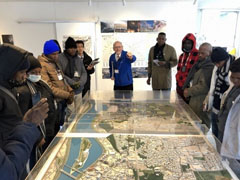 Briefing on reconstruction process in Ishinomaki City, given by Mr. Richard Halberstadt, Director of the Ishinomaki City Reconstruction and Information Exchange Center.
Briefing on reconstruction process in Ishinomaki City, given by Mr. Richard Halberstadt, Director of the Ishinomaki City Reconstruction and Information Exchange Center.
Efforts on land use/relocation plan, land readjustment with community vitalization (Feb. 21, 2020)
The participants visited Natori City to learn land use planning with a hazard map, formulation of the group relocation program, land readjustment project, and community revitalization in a lecture session by Mr. Kenji Yasumoto, Pacific Consultants. In the afternoon, they visited and observed the Kawamachi Terrace Yuriage shopping mall, the Yuriage Community Center, disaster restoration houses, a housing complex for disaster risk reduction and group relocation, and a fishery processing factory. Because of the good weather, they could clearly see the Natori River and mountains covered with snow from Kawamachi Terrace Yuriage shopping mall.
During lunch, fried chicken (Karaage in Japanese) was popular among the participants. They also enjoyed Takoyaki (ball-shaped Japanese dumplings with octopus), as the octopus is a local specialty in Mozambique. Through the training session, they asked many questions on housing reconstruction, and coordination between citizens and city officials, such as "What is the mechanism of the Japanese housing system? What kind of standards are stipulated to judge the degree of collapsed buildings at disasters? How did the city officials communicate their policy with citizens for collaboration? Was the subsidy provided when the business operation resumed?" Besides, seeing the standardized evacuation center sign on the rooftop of Yuriage Community Center and reconstruction houses (which were set as evacuation centers) and learning the information sharing method through evacuation drill, participants felt that they could implement this system in Mozambique as well.
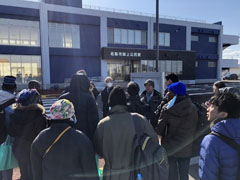 The participants were briefed by Mr. Yasumoto on town development for reconstruction in Natori City in front of Yuriage Community Center, observing the facility.
The participants were briefed by Mr. Yasumoto on town development for reconstruction in Natori City in front of Yuriage Community Center, observing the facility.
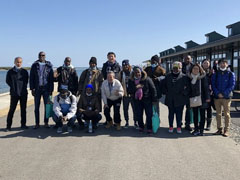 Group photo at Kawamachi Terrace Yuriage shopping mall.
Group photo at Kawamachi Terrace Yuriage shopping mall.
Operation of the evacuation center led by a private sector (Feb. 22, 2020)
After learning reconstruction status for local industries in a sake brewery and a seafood wholesale market, the participants boarded in a sightseeing boat to observe the coastal line. Once they arrive in Matsushima Town, they visited the Zuiganji Temple, where cedar trees were damaged by saltwater of the 2011 tsunami. At the seafood wholesale market, participants walked around by themselves and looked for fish that they know, tasted a wide range of processed food, and grasped ideas on processed food. Some participants bought "Kamaboko" (processed fish paste product) for a snack.
After the visit to the temple, the participants got on a bus for one hour, moving to the Minami Sanriku Hotel Kanyo. After they finished checking in, based on her own earthquake experiences in the disaster, the hotel manager Ms. Keiko Abe lectured on the use of a private facility as an evacuation center, critical points in the evacuation management planning, and collaboration with administrative organizations. After the lecture, participants commented, "It was difficult to collaborate smoothly with the community. The lecture gave very beneficial lessons for us. As Cyclone Idai damaged power, water, and other infrastructures, officials had difficulty in both working for rescue activities and caring for families. I am also proud of Ms. Abe's efforts as a woman. As the Beira Municipality is vulnerable to climate change, we want to build disaster-resistant buildings and multifunctional facilities serving as an evacuation center in the future."
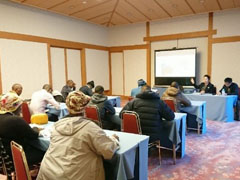 Lecture by Ms. Abe at the Hotel Kanyo.
Lecture by Ms. Abe at the Hotel Kanyo.
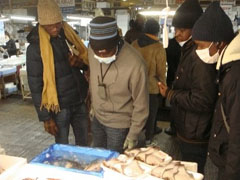 Participants observing fish products in Shiogama Seafood Wholesale market.
Participants observing fish products in Shiogama Seafood Wholesale market.
- Highlights -
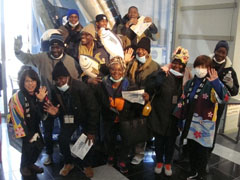 Participants at the photo spot in Marine Gate Shiogama before boarding a boat on Feb. 20. Stuffed fish doll was popular, and the photo session was started to take photos with the fish.
Participants at the photo spot in Marine Gate Shiogama before boarding a boat on Feb. 20. Stuffed fish doll was popular, and the photo session was started to take photos with the fish.
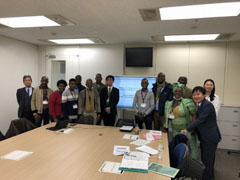 Sérgio, impressed by Mr. Aoki's passion for reconstruction, said, "We want to tackle reconstruction or disaster measures like you." All the participants on the spot shared the enthusiasm, saying "We want to take action with a renewed sense of feeling against construction!"
Sérgio, impressed by Mr. Aoki's passion for reconstruction, said, "We want to tackle reconstruction or disaster measures like you." All the participants on the spot shared the enthusiasm, saying "We want to take action with a renewed sense of feeling against construction!"
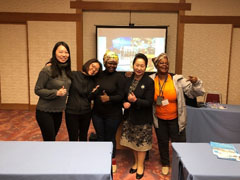 Group photo of female leaders only, suggested by Ana (center) and Luisa (right), taken on Feb. 22.
Group photo of female leaders only, suggested by Ana (center) and Luisa (right), taken on Feb. 22.
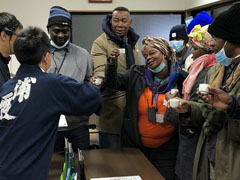 Participants were tasting sake at Urakasumi Sake Brewery in Shiogama City on Feb. 22. Luisa (center) enjoyed tasting and eventually bought a bottle of favorite sake as a souvenir.
Participants were tasting sake at Urakasumi Sake Brewery in Shiogama City on Feb. 22. Luisa (center) enjoyed tasting and eventually bought a bottle of favorite sake as a souvenir.
- About JICA
- News & Features
- Countries & Regions
- Our Work
- Thematic Issues
- Types of Assistance
- Partnerships with Other Development Partners
- Climate Change / Environmental and Social Considerations
- Evaluations
- Compliance and Anti-corruption
- Science and Technology Cooperation on Global Issues
- Research
- JICA Development Studies Program / JICA Chair
- Support for the Acceptance of Foreign HRs / Multicultural and Inclusive Community
- Publications
- Investor Relations
